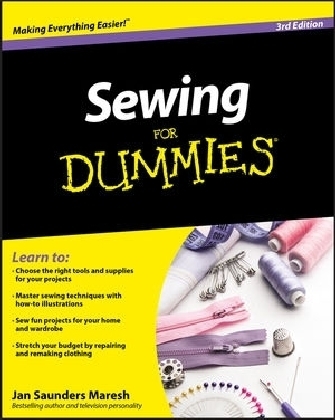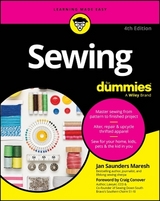
Sewing For Dummies
For Dummies (Verlag)
978-0-470-62320-6 (ISBN)
The most complete guide to sewing basics People are always looking for ways to cut expenses and be creative and stylish at the same time. Learning to sew is a great way to arm yourself with the skills to repair and create clothing and furnishings for yourself and your family for little to no cost. But learning how to sew and how to choose the tools and supplies to begin sewing can be confusing.
Now, you can turn to this hands-on, friendly guide for the most up-to-date information, the best techniques, and fun projects for learning (or brushing up on) the art of sewing.
Easy-to-follow instructions and step-by-step illustrations make it easier to learn
Fresh new patterns, projects, stitches, and techniques for fashion and the home
Budget-conscious tips for breathing new life into existing garments
Complete with a section on common sewing mistakes and how to avoid them, Sewing For Dummies, 3rd edition gives you the confidence and know-how to sew like a pro.
Jan Saunders Maresh is a nationally known sewing journalist and educator as well as a bestselling author of 15 books, including Home Staging For Dummies. She has worked as the Director of Consumer Education for White Sewing Machine Company and JoAnn Fabrics and is also an interior re-designer, color specialist, and Certified Staging Professional. Look for her Web-TV show at www.nakedroomsolutions.tv.
Introduction 1
About This Book 1
Conventions Used in This Book 2
Foolish Assumptions 2
How This Book Is Organized 2
Part I: Getting Ready to Sew 2
Part II: Mastering Basic Sewing Skills 3
Part III: Fashion Sewing Fun-damentals 3
Part IV: Sewing for Your Home 3
Part V: Making Alterations and Quick Fixes for a Sustainable Wardrobe 3
Part VI: The Part of Tens 3
Icons Used in This Book 4
Where to Go from Here 4
Part I: Getting Ready to Sew 5
Chapter 1: The World of Sewing 7
Figuring Out What Comes First: The Idea or the Tools? 8
The pleasure of using good tools 8
Understanding fabrics and fibers 9
Getting the sewing notion 10
Pondering the pattern 10
Sizing Up the Sewing Process 11
Preshrinking fabric 11
Finding the right pattern pieces 12
Laying out the pattern on the fabric 12
Pinning and cutting 12
Marking 12
Interfacing 12
Pressing for the best shape 13
Moving On to the Needle and Thread 13
Finishing the edges first 13
Shaping 13
Seaming 14
Closing 14
Hemming 14
Adding Fashion Detail with Sleeves and Pockets 15
Sewing for the Home Is Where the Saving Is 15
Doing Your Part for the Planet with a Sustainable Wardrobe 16
Chapter 2: Assembling Your Sewing Kit 17
Making Sure Your Sewing Measures Up 18
Cutting Up (Without Cracking Up) 20
Making Your Mark 22
Pinning Down Your Projects 23
Getting to the Point with the Right Needles, Thimbles, and Seam Rippers 23
Selecting needles for hand sewing 23
Selecting needles for sewing machines 24
Fortify your fingertips with thimbles 24
As ye sew, so shall ye rip 25
Selecting Thread for Your Project 25
Pressing Issues 26
Real Machines: Sewing Machines and Sergers 28
Working with a sewing machine 29
Finding your way around a serger 35
Chapter 3: Selecting Fabric, Findings, and Interfacing 37
Choosing the Right Fabric for Your Project 37
Figuring out fiber 38
Getting to know common fabric types 39
Taking fabric nap into consideration 43
Considering fabric width and yardage needed 45
Reading labels and bolt ends 45
Getting Notions about Findings 46
Bias tape basics 46
Bonkers for braid 47
Getting elastic 47
Loving lace 48
Piping up for piping and cording 49
Running with ribbons 50
Refreshing with rickrack and twill tape 50
Getting the lowdown on drapery headers 51
Adding zip with zippers 51
Investigating Interfacing 52
Preshrinking Your Fabric 53
Chapter 4: Working with Patterns 55
Shopping for Patterns 55
Sizing Things Up for Fashion Sewing 56
Deciphering the Pattern and Its Parts 58
Checking out the front of the pattern envelope 59
Reading the back of the pattern envelope 59
It’s what’s inside that counts 60
Decoding the pattern pieces 60
Laying Out the Pattern 63
Getting to know your fabric 63
Preparing the fabric 64
Knowing right from wrong 64
Placing the pattern pieces on-grain 64
Laying out plaids, stripes, and one-way designs 66
Pinning and Cutting Out the Pieces 70
Making Your Mark 71
Marking what matters 71
Using the right tool at the right time 72
Part II: Mastering Basic Sewing Skills 75
Chapter 5: Kicking Off Your Sewing Adventure 77
Threading the Needle 77
Hand needles 78
Machine needles 79
Tying a Sewing Knot 80
Choosing and Using the Right Hand Stitches 82
The securing stitch 83
The hand-basting stitch 83
The running stitch 84
The even backstitch 84
The blind hemming stitch 85
The slant hemming or whip stitch 85
The hemming slipstitch 86
The even slipstitch 86
Working with Machine Stitches 87
Examining the basic machine stitches 87
Selecting a stitch type 89
Choosing the length of the stitch 89
Setting the stitch width 90
Stitching in the ditch 90
Topstitching 91
Starting and Stopping 92
…with your sewing machine 92
…with your serger 93
Basting Projects for a Better Fit 94
Pressing Matters 96
Why press and iron as you sew? 96
When and where to press 96
Pressing napped fabrics 97
Repurposed Shirt Pillow 98
Chapter 6: Securing Sensational Seams 103
Finishing the Edges First 103
Pinking your edges 104
Using your sewing machine or serger 104
Securing Your Seams 105
Backstitching or not 106
Tying off threads 106
Fleece Throw with Colorful Fringe 107
Seaming Fabrics 111
Sewing straight seams 111
Turning corners 113
Sewing 1⁄4-inch seams 114
Serging 1⁄4-inch seams 115
Ripping into Seam Mistakes 116
Shaping Up the Seams 118
Starting by stitching the seam on your sewing machine 118
Clipping the curve with your scissors 122
Chapter 7: Fast and Easy Hems by Hand and Machine 125
Marking the Hem’s Placement 126
If you’re the hem-ee 126
If you’re the hemmer 126
Deciding on the Hem Allowance 127
Finishing the Raw Edges of the Hem 128
Using a straight stitch 128
Using a three-step zigzag or overlock stitch 130
Using a serger 130
Securing the Hem 131
No-sew hemming 132
Pinning up the hem for hand or machine hemming 133
Hand blind hemming 133
Machine blind hemming 134
Sewing Tapered Hems 135
Hemming Knits with Twin Needles 136
Part III: Fashion Sewing Fun-damentals 139
Chapter 8: Shaping Things Up 141
Darting Around 141
Sewing the straight dart 142
Sewing the contour dart 144
Finishing the dart 145
Gathering Fabric from One Piece into Another 145
Gathering with two threads 146
Gathering over a cord 147
Ruffled Apron 148
Cutting out the apron parts 149
Finishing the apron side seams 150
Gathering and attaching the ruffle strip 151
Tying up the apron strings 152
Completing Pleats 154
Defining the types of pleats 154
Making a pleat 155
Adding Stretch and Comfort with Elastic 156
Inserting elastic in a casing 157
Attaching elastic on an edge 160
Cuffed Pajama Pants 163
Laying and cutting out your pj’s 164
Sewing your pj’s together 166
Sewing elastic at the waist 167
Cuffing each leg 168
Chapter 9: Zippers, Buttons, and Other Closure Company 171
Welcoming Easy Ways to Put in Zippers 171
Putting in a centered zipper 172
Putting in an invisible zipper 176
Mastering Buttonhole Basics 180
Sizing buttonholes 181
Marking buttonholes 182
Sewing beautiful buttonholes 183
Cutting open buttonholes 183
Figuring out button placement 185
Attaching buttons 186
Checking Out Other Fasteners 191
Fold-Over Clutch with Button Closure 192
Choosing the materials 193
Sewing the clutch 194
Chapter 10: Sleeves: The Long and the Short of It 197
Finishing Sleeveless Armholes 197
Facing sleeveless armholes 198
Binding sleeveless armholes 201
Rarin’ to Sew Raglan Sleeves 203
Taking On Set-In Sleeves 206
Using easestitch-plus to prepare traditional set-in sleeves 207
Setting sleeves in flat 209
Setting sleeves in the round 210
Protective Laptop Sleeve 212
Chapter 11: Pockets Full of Ideas 215
Putting Together Patch Pockets 215
Making unlined patch pockets with square corners 216
Making unlined patch pockets with curved corners 218
Attaching patch pockets 221
Using Your Own Pocket Patterns 222
Coordinating Pocket-Collage Shirt 224
Part IV: Sewing for Your Home 225
Chapter 12: Do-It-Yourself Decorating: Home Décor Sewing 227
Overcoming Décoraphobia 227
Understanding color 228
Unmasking your home’s complexion 228
Determining your color odds 229
Homing In on Home Decor Fabric 230
Tackling Trim 231
Braving braid basics 231
Conquering cord 232
Figuring out fringe 233
Dealing with decorator trims 234
Attaching Piping, Cording, and Fringe 235
Making your own piping 236
Cutting bias strips for covering cable cord 237
Sewing on piping and fringe 240
Attaching and joining cord-edge trim 244
Reversible Table Runner 245
Chapter 13: Quick-Change Table Toppers 247
Selecting Fabric for Table Toppers 247
Making Easy Napkins 248
Figuring out fabric yardage 248
Sewing basic table napkins 249
Serging napkins with narrow rolled edges 251
Party-Ready Lapkins 253
Hip to Be Square Tablecloth 255
Chapter 14: Praiseworthy Pillows 257
Selecting Materials for Pillows 257
A Basic Cover Fit for a Pillow Form 258
Measuring your pillow form and cutting the pillow front and back 258
Sewing the seams 259
Wrapping the corners 260
Stitching the closure 261
The Easiest Reversible Pillow Cover Ever 262
15-Minute Flanged Pillow Cover 264
Plush Pet Bed 265
Making the bolster 266
Creating the fleece pillow cover 267
Putting the bed together 269
Box-Edged Pillow 270
Chapter 15: Adding Wow to Your Windows 273
The Wide World of Window Treatments 273
Dealing with draperies and curtains 274
Exploring the anatomy of windows and rods 276
Determining Window Treatment Dimensions 278
Measuring the finished width and length 279
Calculating cut fabric length and width 279
Custom Draperies 282
Determining how much fabric you need 283
Putting the drapery together 284
Heading off rips with the drapery header 286
Chapter 16: Giving Your Bed a Makeover 289
Saving Money by Crafting a Bedding Set 289
Pleated Bed Skirt 290
Measuring the box spring 291
Buying your fabric 292
Cutting the fabric 292
Double hemming the skirt and pleats 294
Attaching the skirt and pleats to the base fabric 296
Positioning the bed skirt on the box spring 297
Custom Duvet Cover 298
Cutting out the front of the duvet cover 299
Constructing the back of the duvet cover 299
Putting everything together 300
Part V: Making Alterations and Quick Fixes for a Sustainable Wardrobe 303
Chapter 17: When Clothes Are Too Short, Too Long, Too Tight, or Too Loose 305
When It’s Too Short 305
Cutting off pant legs and re-hemming them 306
Letting down and facing the hem 306
Adding ribbing into an opening 308
When It’s Too Long 310
Moving the button on a sleeve cuff 310
Removing the cuff to shorten the sleeve 311
Shortening jeans 313
When It’s Too Tight 315
Moving the buttons over on a jacket 315
Adding room to the waistband 315
When It’s Too Loose 317
Crossover Belt 318
Chapter 18: Making Repairs on the Run 321
Repairing a Split Seam 321
Repairing a seam on woven fabrics 321
Repairing a seam on knit fabrics 322
Patching Holes and Rips 323
Covering holes with patches 323
Patching with appliques 325
Mending Tears in Fabric 326
Replacing a Fly-Front Zipper 327
Chapter 19: Eco Fashion: Giving Existing Garments New Life 331
Felted Wool Hat 332
Sourcing and preparing the wool 332
Felting the wool 333
Laying out and cutting the hat pieces 333
Assembling the hat 335
(Almost) Instant Party Dress 339
Finding the perfect bra and fabric 339
Cutting out the skirt and straps 340
Making the skirt 340
Sewing the straps 343
Hemming the dress 344
Part VI: The Part of Tens 345
Chapter 20: Ten Tips for Mixing Prints 347
Stick with One Base 347
Run a Background Check 347
Go Solid and Save Money 348
Mix ’n’ Match Manufacturers 348
Stare Down Your Prints 348
Weigh the Scales 348
Try Before You Buy 349
Rely on a Collection 349
Buy More, Use Less 350
Consult a Pro 350
Chapter 21: Ten Rookie Sewing Mistakes to Avoid 351
Attempting a Project Beyond Your Skill Level 351
Choosing Difficult Fabrics to Work With 352
Choosing an Unflattering Style 352
Using the Wrong Fabric for the Pattern 352
Laying Out the Fabric Incorrectly 353
Neglecting to Use Interfacing 353
Failing to Press as You Sew 353
Using an Old, Beat-Up Sewing Machine 353
Neglecting to Use a New Needle on Every Project 354
Refusing to Cut Yourself Some Slack 354
Chapter 22: Ten Important Sewing Fundamentals 355
Buy the Best Fabric You Can Afford 355
Understand Your Fabric Terminology 356
Know the Difference between Right and Wrong 356
Put Your Foot Down before Sewing 357
Stop and Start Sewing the Right Way 357
Righty, Tighty; Lefty, Loosey 358
Test-Stitch First 358
Sew from the Bottom Up and from the Center Out 359
Press Seams Together and then Open or to One Side 359
Clip with the Tips of Your Scissors 360
Appendix: Sewing Resources 361
Sewing Organizations 361
Sewing Publications 361
Sewing Community Web Sites 362
Sewing Machine Manufacturers 362
Pattern Companies 363
National Fabric Stores 363
Regional Fabric Stores 364
Notion Companies 365
Fabric and Notion Mail-Order Companies 366
Thread Manufacturers 366
Index 367
| Erscheint lt. Verlag | 27.8.2010 |
|---|---|
| Sprache | englisch |
| Maße | 185 x 234 mm |
| Gewicht | 567 g |
| Themenwelt | Sachbuch/Ratgeber ► Freizeit / Hobby ► Handarbeit / Textiles |
| ISBN-10 | 0-470-62320-9 / 0470623209 |
| ISBN-13 | 978-0-470-62320-6 / 9780470623206 |
| Zustand | Neuware |
| Haben Sie eine Frage zum Produkt? |
aus dem Bereich



